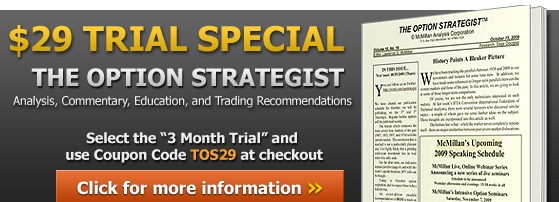
By Lawrence G. McMillan
Often at expiration, an option trader will have in-the-money options that need to be either exited or rolled. Market makers know this and purposely widen the spreads in the market so that the bid for the option is below parity. On expiration day, the option has a value of at least parity so the astute trader must always make sure he exits the position at parity or higher. For a put, parity is the strike price minus the underlying price.
In the example below from last November, we were long in-the-money puts at expiration and wanted to roll them down and out, so we offered the following instructions and explanation:
The EWZ November 51 puts expire tomorrow (Friday, November 15th). We want to maintain a position here, but would also like to take some profit out of the position. Roll the puts down to the December 2013 48.5 puts. That is, execute this trade (preferably as a spread order, so that one is not “legging” into the trade).
At current prices, this spread would be a credit of $1.22, meaning you would pocket a credit of $122 (less commissions) per spread. Do not sell the EWZ November 2013 51 puts below parity. For example, if EWZ is trading at $47.60, then parity for the November 2013 51 put is $3.40 ($51.00 minus $47.60). The bid in the marketplace might be slightly less than $3.40, as market makers try to make some “free” money near expiration.
One way that you can counter them is to use a limit order on your spread. Assume that the December 2013 48.5 put is offered at $2.15. So, if the above prices existed, then your spread order would be entered for a limit of $3.40 minus $2.15, or $1.25 credit.
Obviously, as prices change, the spread order limit would change as well.
One final point: If the market makers will not fill you at a spread order involving parity for the November 2013 51 put, then you can force parity yourself. This is a little bit more advanced technique, but it is worth learning, for it can save you some money. Suppose that the above prices exist: EWZ = $47.60 and December 2013 48.5 put = $2.15, but you are not getting filled at your $1.25 credit for the spread.
Then it might be best to exit without a spread order. You can always force parity for the sale of a put by a) buying the underlying stock, and b) exercising your put. In this case, a) would mean buying EWZ at $47.60 and then b) would mean exercising your November 2013 51 put thereby selling EWZ at the striking price of $51.00.
Therefore you would have exited your put position at $51.00 minus $47.60, or $3.40.
Then you could merely go into the open market and buy the December 2013 48.5 put as a single option order (i.e., not a spread).
If you are trading through an option-oriented brokerage firm, your broker should understand this method of exiting a long option position, and there would not be any margin requirement to exit the put in this manner. But you would likely have to call the trading desk in order to execute it that way. If you just try to execute it online, the broker’s computer system will want you to pay for the stock, which you do not have to do if you have already issued irrevocable instructions to exercise the put. This means that you’ll have to go through a human being, most likely, in order to effect the exit of the put via exercise.
Hopefully, you will be able to exit via the spread order and will not have to delve into exercising the put. However, keep this information in mind for educational purposes. It may prove to be useful in the future.
For more educational option information, refer to Options As A Strategic Investment. For option trading recommendations, complete with follow-up action, subscribe to The Option Strategist Newsletter.
© 2023 The Option Strategist | McMillan Analysis Corporation

